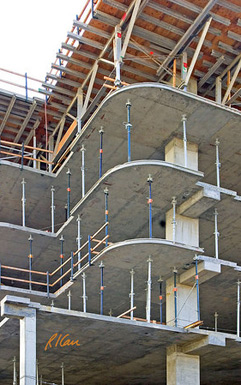Bay Area Concrete Aggregates |
|||
|
Bay Area Aggregate History Two factors have influenced the evolution of aggregate supplies and suppliers in the San Francisco Bay Area over the last 35 to 40 years: (1) urban development around the sources, and (2) the focus on, or the demand for, improving performance issues such as strength, durability, creep, and shrinkage resistance. Unlike many of the areas of the state, (especially southern California) we are fortunate in the Bay area to have had very high quality aggregate sources available locally. However, population pressures have made it all but impossible to obtain new or extended permits for aggregate mining and processing in the greater Bay Area. As the existing pits run out, and as permitting new sources becomes more difficult, other sources (such as imports) have become more prevalent. Concrete performance issues, particularly creep and shrinkage, came into the forefront locally in the 1960’s as a result of excessive deflection exhibited in the flexural members of several newly-designed Bay Area structures. Refinements in design procedures and higher strength reinforcement had resulted in the use of shallower members and longer spans. In some cases however, deflections were greater than calculated, leading to the suspicion that creep and/or shrinkage in the concrete was the cause. A 1965 SEAOC study, supplemented in 1974 (Appendix II) discussed causes and effects of creep and shrinkage in concrete. Aggregates that effectively aid in restraining shrinkage of the cement paste are the stronger, more durable and chemically stable materials such as quartz, feldspar, limestone, dolomite and granite. The study points out that other variables, such as aggregate size (larger aggregate, less shrinkage), gradation (to reduce paste volume), and cement source (shrinkage can vary by a factor of 2 for different cements) have the potential for even greater effects on creep and shrinkage. Bay Area aggregates include limestone and granite, along with other hard and durable rocks such as basalt and diabase. The SEAOC study led to the conclusions that several local aggregates contributed to low-shrinkage in the concrete: Graniterock Company, A.R. Wilson Quarry, Aromas, a granite material. Hansen Aggregates, Cupertino, “Permanente limestone”. Felton/Olympia, Santa Cruz, several suppliers, fine aggregate, now depleted. RMC Pacific (now Cemex), Clayton plant, a diabase material Engineers needing concrete with good shrinkage performance were able to specify aggregates from these sources with a reasonable expectation that the aggregate’s contribution to limited shrinkage would be maximized. |
 Home
Home
|
||
